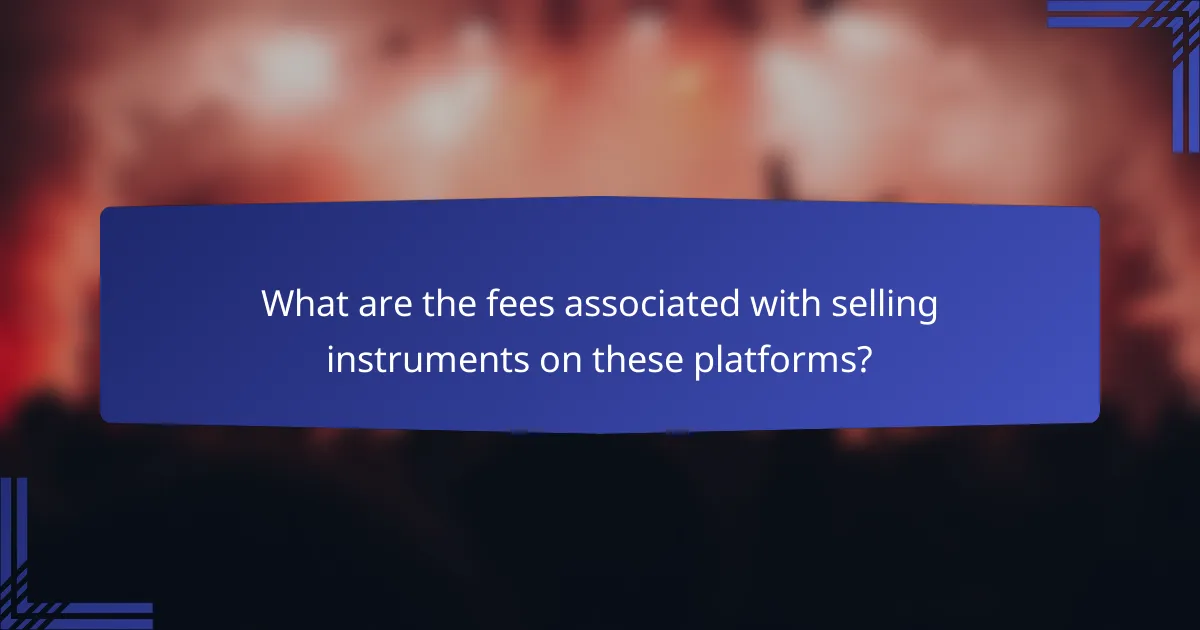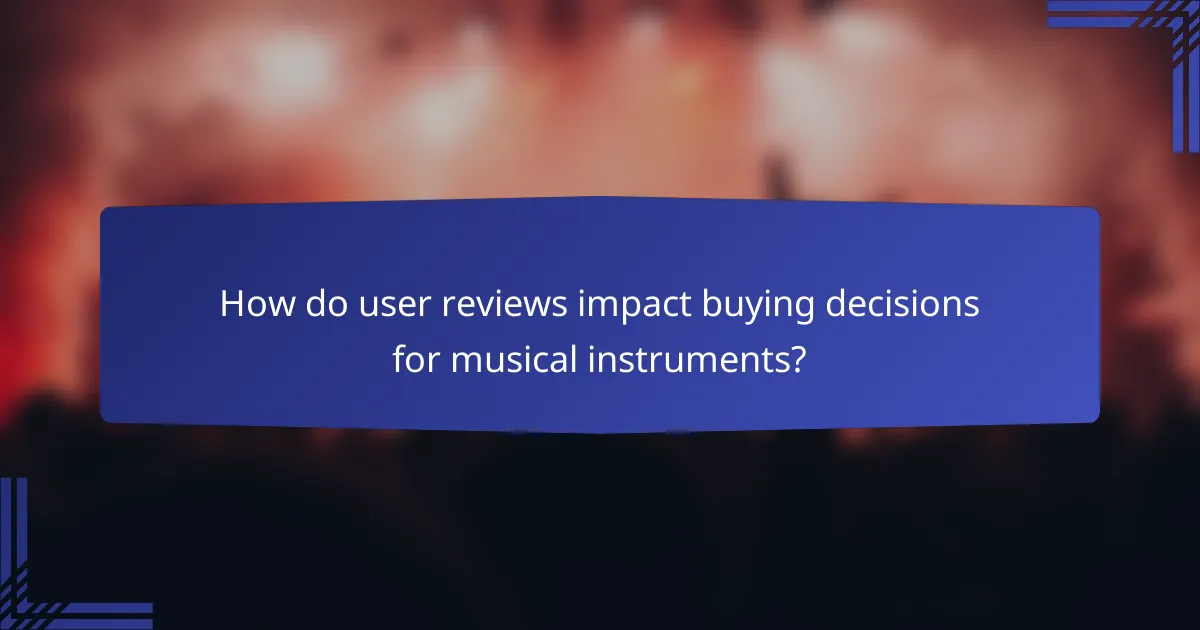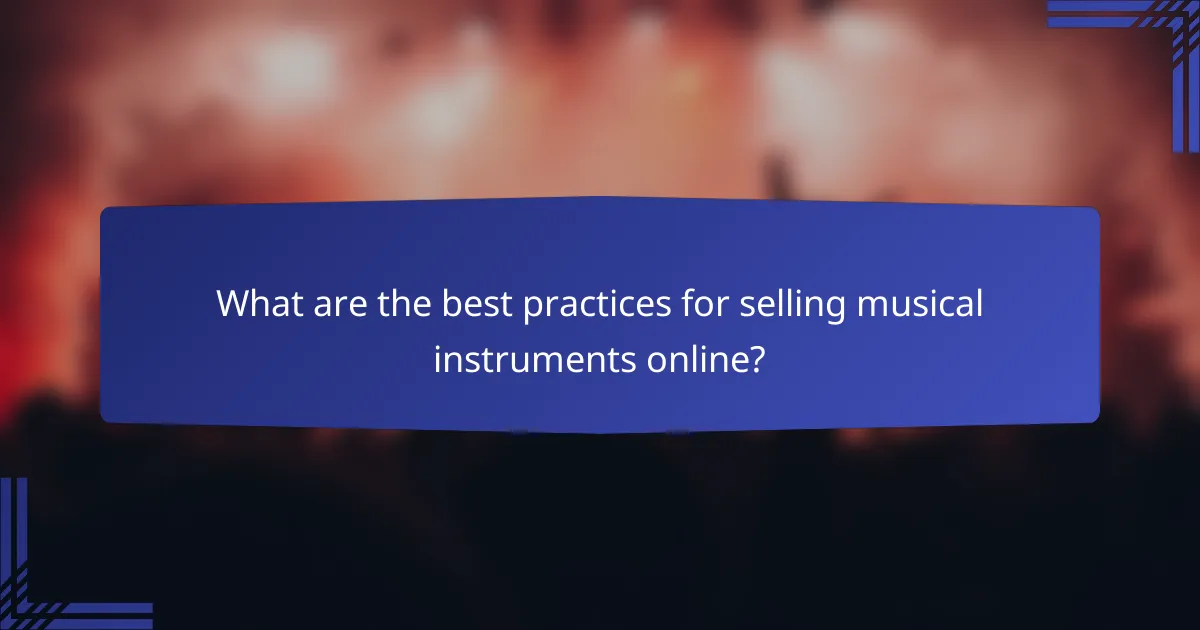When it comes to buying and selling musical instruments, selecting the right platform is essential for a successful transaction. Various specialized marketplaces and general selling sites offer distinct features, fees, and user experiences that can influence your choices. Additionally, user reviews play a crucial role in assessing product quality and seller reliability, helping buyers make informed decisions. Understanding the associated fees is also vital for sellers to maximize their profits.

Which platforms are best for buying musical instruments in the US?
The best platforms for buying musical instruments in the US include specialized marketplaces and general selling sites that cater to musicians. Each platform has unique features, fees, and user experiences that can significantly impact your purchasing decision.
Reverb
Reverb is a dedicated marketplace for musicians, offering a wide range of new and used instruments. Sellers can list items easily, and buyers benefit from a user-friendly interface and extensive product categories.
Consider the seller fees, which typically range from 3.5% to 5% of the sale price, depending on the listing type. Reverb also provides buyer protection, ensuring a safer transaction experience.
eBay
eBay is a well-known auction and fixed-price platform where you can find a diverse selection of musical instruments. It allows for bidding on items, which can sometimes lead to lower prices.
Keep in mind that eBay charges seller fees that can be around 10% of the final sale price, plus additional fees for listing. Always check seller ratings and reviews to ensure a reliable purchase.
Guitar Center
Guitar Center operates both physical stores and an online platform, providing a wide selection of instruments, gear, and accessories. They often have sales and promotions, making it a good option for budget-conscious buyers.
When purchasing online, consider their return policy, which typically allows returns within 30 days. You can also find used instruments, often at competitive prices, but inspect them carefully before buying.
Facebook Marketplace
Facebook Marketplace allows users to buy and sell items locally, including musical instruments. This platform is convenient for finding deals in your area, often with no shipping costs involved.
However, transactions are typically cash-based, so ensure you meet in a safe location and verify the instrument’s condition before finalizing the purchase. Be cautious of scams, as buyer protection is limited.
Craigslist
Craigslist is another local classifieds platform where you can find a variety of musical instruments. Listings are often posted by individuals looking to sell directly, which can lead to lower prices.
Like Facebook Marketplace, transactions are usually cash-based and require meeting in person. Always inspect the instrument thoroughly and negotiate the price if necessary. Be wary of listings that seem too good to be true, as they may be scams.

What are the fees associated with selling instruments on these platforms?
The fees for selling musical instruments vary significantly across different platforms. Understanding these costs is crucial for maximizing your profits and making informed choices when listing your items.
Reverb selling fees
Reverb charges a selling fee of around 5% on the final sale price, which is deducted from your earnings. Additionally, there may be payment processing fees, typically around 3% plus a small fixed fee per transaction.
Sellers should consider the total cost when pricing their instruments. For example, if you sell an item for $200, you might end up with approximately $180 after fees.
eBay selling fees
eBay’s selling fees can vary based on the type of listing and whether you have a store subscription. Generally, eBay charges a final value fee of about 10% of the total selling price, including shipping costs.
Be aware that eBay also has listing fees if you exceed a certain number of free listings per month. For instance, if you sell a guitar for $300, you could pay around $30 in fees, plus any applicable listing charges.
Guitar Center consignment fees
Guitar Center typically charges a consignment fee that ranges from 20% to 30% of the sale price. This fee is deducted from the final sale amount once the instrument is sold.
Using consignment can be beneficial if you prefer not to handle the sale directly, but it’s essential to factor in these fees when setting your price. For example, if your instrument sells for $500, you might receive between $350 and $400 after fees.
Facebook Marketplace fees
Facebook Marketplace does not charge sellers fees for local transactions, making it an attractive option for selling instruments directly to buyers. However, if you opt for shipping, Facebook takes a selling fee of about 5% on shipped items.
When selling locally, you can keep the full sale price, but ensure you meet in safe, public locations. For shipped items, if you sell a guitar for $200, you would pay around $10 in fees if shipped through Facebook’s service.

How do user reviews impact buying decisions for musical instruments?
User reviews significantly influence buying decisions for musical instruments by providing insights into product quality and seller reliability. Potential buyers often rely on feedback from previous customers to gauge the performance and durability of instruments before making a purchase.
Importance of user reviews
User reviews serve as a critical resource for musicians seeking to make informed purchases. They offer firsthand experiences that highlight both the strengths and weaknesses of specific instruments. A high volume of positive reviews can enhance trust in a product, while negative feedback may deter potential buyers.
Moreover, reviews can reveal details about the instrument’s playability, sound quality, and overall value for money. This information is especially valuable for those purchasing online, where they cannot physically test the instrument before buying.
Top-rated instruments on Reverb
Reverb is a popular platform for buying and selling musical instruments, known for its extensive user reviews. Instruments that consistently receive high ratings often include electric guitars, synthesizers, and vintage gear. Buyers can filter search results by user ratings to find top-rated options that suit their needs.
For example, a well-reviewed electric guitar might have dozens of positive comments praising its sound and build quality, making it a safer choice for buyers. Additionally, Reverb’s community-driven feedback helps identify trends in instrument popularity and reliability.
Feedback on eBay sellers
eBay is another significant marketplace for musical instruments, where user feedback plays a crucial role in assessing seller credibility. Buyers should pay close attention to seller ratings and read reviews to ensure they are purchasing from reputable sources. A seller with a high positive feedback percentage is generally more trustworthy.
Furthermore, eBay allows users to leave detailed reviews about their transaction experiences, including shipping speed and item condition. This feedback helps future buyers make informed decisions and avoid potential pitfalls, such as purchasing from sellers with a history of complaints.

What are the best practices for selling musical instruments online?
To sell musical instruments online effectively, focus on presenting your items attractively, providing clear information, and setting fair prices. These practices will help you attract buyers and close sales more efficiently.
High-quality photos
High-quality photos are essential when selling musical instruments online. Use natural lighting and multiple angles to showcase the instrument’s condition and features. Ensure that images are clear and detailed, allowing potential buyers to see any wear or unique characteristics.
Consider including close-ups of important areas, such as the neck, body, and any accessories. A well-lit, visually appealing presentation can significantly increase buyer interest and trust.
Detailed descriptions
Providing detailed descriptions is crucial for informing potential buyers about the instrument’s specifications and condition. Include information such as the brand, model, year of manufacture, and any modifications or repairs made. Highlight unique features that set your instrument apart.
Be honest about any flaws or signs of wear, as transparency builds trust with buyers. A well-crafted description can help buyers feel more confident in their purchasing decision.
Competitive pricing strategies
Setting a competitive price is vital for attracting buyers. Research similar instruments on various platforms to gauge the market value. Consider factors such as condition, age, and brand reputation when determining your price.
Avoid overpricing, as it can deter potential buyers. Offering a slight discount or being open to negotiation can also encourage sales. Remember to factor in any fees from the selling platform when setting your final price.

What should buyers consider when purchasing used instruments?
When purchasing used musical instruments, buyers should focus on the instrument’s condition, return policies, and shipping costs. These factors significantly impact the overall value and satisfaction of the purchase.
Condition assessment
Assessing the condition of a used instrument is crucial. Look for signs of wear, such as scratches, dents, or rust, and check that all parts are functional. If possible, play the instrument to evaluate its sound quality and playability.
Consider asking the seller for detailed photos and descriptions of any imperfections. A well-maintained instrument can often be worth significantly more than one that has been neglected, so ensure you understand the specific condition before buying.
Return policies
Return policies vary widely among sellers, making it essential to understand the terms before completing a purchase. Some platforms offer a satisfaction guarantee, allowing returns within a specified period, while others may have strict no-return policies.
Always read the fine print regarding returns, including any restocking fees or conditions that must be met for a return to be accepted. Knowing these details can save you from potential losses if the instrument does not meet your expectations.
Shipping costs
Shipping costs can greatly affect the total price of a used instrument. Be sure to factor in these expenses when comparing prices across different sellers. Some platforms may offer free shipping, while others may charge a premium based on the instrument’s size or weight.
Additionally, consider the shipping method and insurance options. Instruments can be fragile, and proper packaging is vital to prevent damage during transit. Always inquire about the seller’s shipping practices to ensure your purchase arrives safely.

How do shipping and return policies vary across platforms?
Shipping and return policies differ significantly among platforms for buying and selling musical instruments. Factors such as shipping costs, delivery times, and return windows can greatly influence your purchasing experience.
Shipping Costs
Shipping costs can vary widely depending on the platform and the size of the instrument. Some platforms offer free shipping for certain price thresholds, while others may charge a flat rate or calculate fees based on distance and weight. Always check the shipping policy before finalizing your purchase to avoid unexpected charges.
Delivery Times
Delivery times can range from a few days to several weeks, depending on the seller’s location and the shipping method chosen. Many platforms provide estimated delivery dates during checkout, which can help you plan accordingly. If you need an instrument quickly, consider platforms that offer expedited shipping options.
Return Policies
Return policies vary by platform, with some offering generous return windows of 30 days or more, while others may have stricter conditions. It’s crucial to read the return policy details, including any restocking fees or conditions for returns, to ensure you can return an item if it doesn’t meet your expectations. Look for platforms that provide clear instructions for returns to simplify the process.
